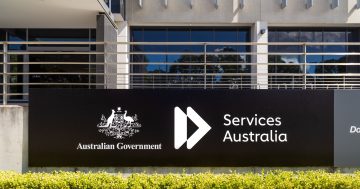
The CPSU wants to wreak havoc on staff monitoring at Services Australia. Image: File.
On the bargaining front when it comes to negotiations over APS wages and conditions, 1 August marks a significant turn on two fronts.
Firstly, the Australian Public Service Commission’s chief negotiator Peter Riordan steps back from the bargaining table to “work through how best to settle the final package of pay and conditions”.
According to an APSC update, APS-wide bargaining has made significant progress over the past three months.
Mr Riordan and his team have been busy considering and hearing more than 1500 claims on pay and conditions across more than 90 categories.
Concessions have been made on some points, while heels have dug in over others.
The update points out that most matters have been discussed multiple times in an effort to develop principles to underpin common clauses for all APS enterprise agreements.
This “significant progress” will see many common conditions move forward to the next phase of the process.
There are two more bargaining meetings scheduled for August to allow all parties to keep advocating their positions.
This brings us to the other significant thing about today.
It’s when industrial action led by the Community and Public Sector Union (CPSU) kicks in at Services Australia.
The CPSU isn’t happy with the government’s pay increase offer and is holding out for a 20 per cent hike over three years across the APS, rejecting the APSC’s offer that comes in at half that.
Thousands of CPSU members throughout the APS have taken part in more than 700 meetings and voted for urgent improvement from the government over its pay offer.
In a bid to force the government’s hand, employees at Services Australia – where the CPSU has a significant membership base – will embark on two weeks of planned industrial action from 1 August.
That action is described as an Auxiliary Code Ban, during which staff will not enter prescribed codes that allow Services Australia management to track their tasks and note what individual employees are doing at any given time.
The union says the industrial action won’t impact frontline services at the agency and that the public will not be adversely affected.
But it does use the term “wreak havoc” when describing what the ban will do to Services Australia’s internal systems of staff monitoring.
“Banning the use of auxiliary codes for two weeks will significantly disrupt internal monitoring and data collection,” says CPSU national secretary Melissa Donnelly.
“And fly in the face of the toxic micro-management culture that exists in Services Australia.”
Donnelly is right in describing the monitoring of staff at Services Australia as “toxic micro-management”. The agency is notorious for it.
Industrial action against such draconian measures would be more than justified under other circumstances.
But during a negotiation process that only comes along every few years and in which parties come to the table with an understanding of mutual respect, linking wages to auxiliary codes seems tenuous and even petty.
Using terms such as “wreak havoc” conjures images of bully-boy tactics for which the CPSU is not normally known.
And while Services Australia might be a CPSU stronghold, it is also an easy target being an agency that has just gone through the wringer over Robodebt and with more pain to come.
It has an image problem and the CPSU is exploiting it.
And if by some means the industrial action does manage to find a way of affecting Australians needing welfare and social services, it will be the agency that will have to wear the flack.
In a negotiation process that has seen the CPSU secure a number of solid wins and improvements for its members, the tactic it is employing over wages seems a tad off point.



















